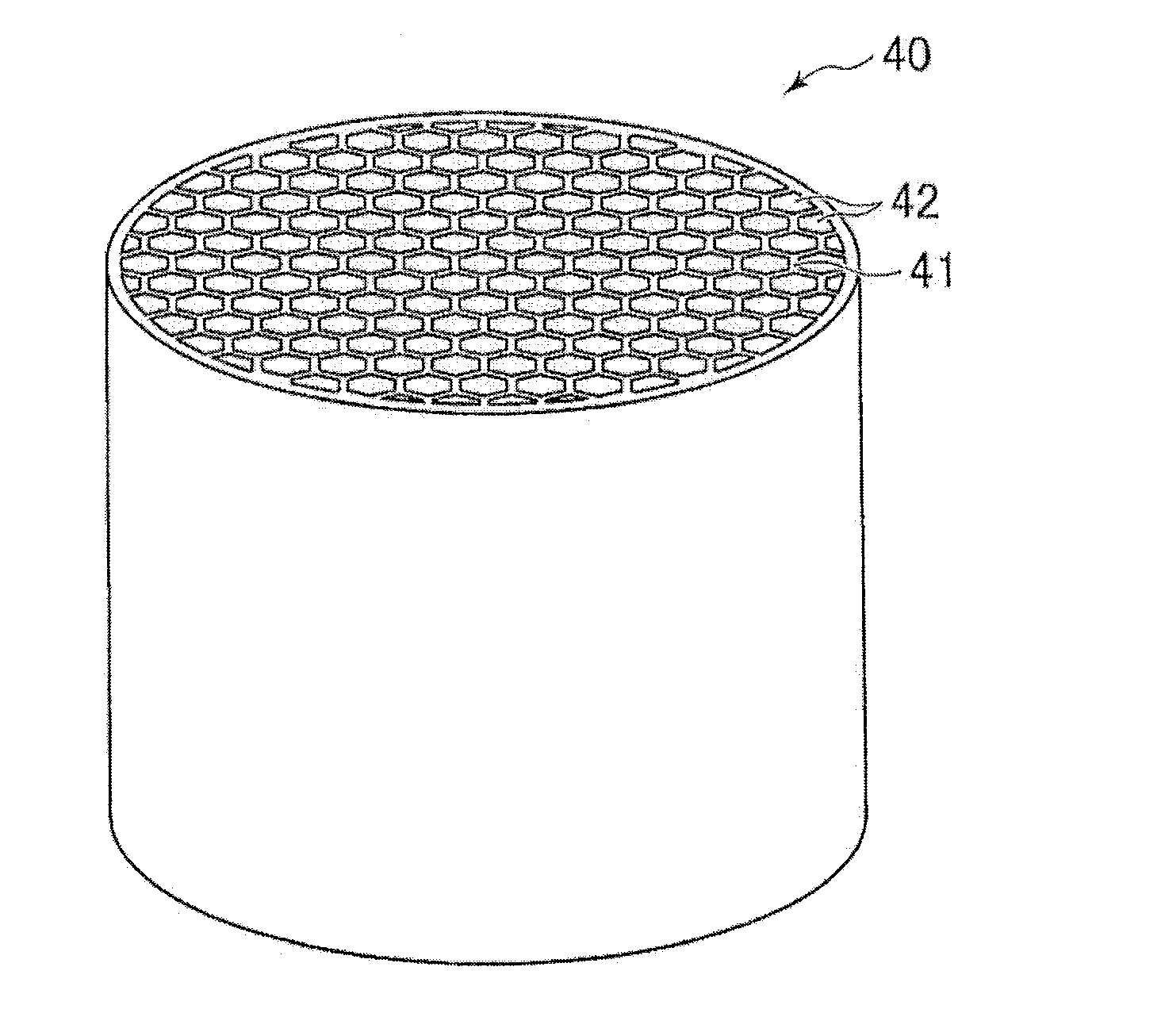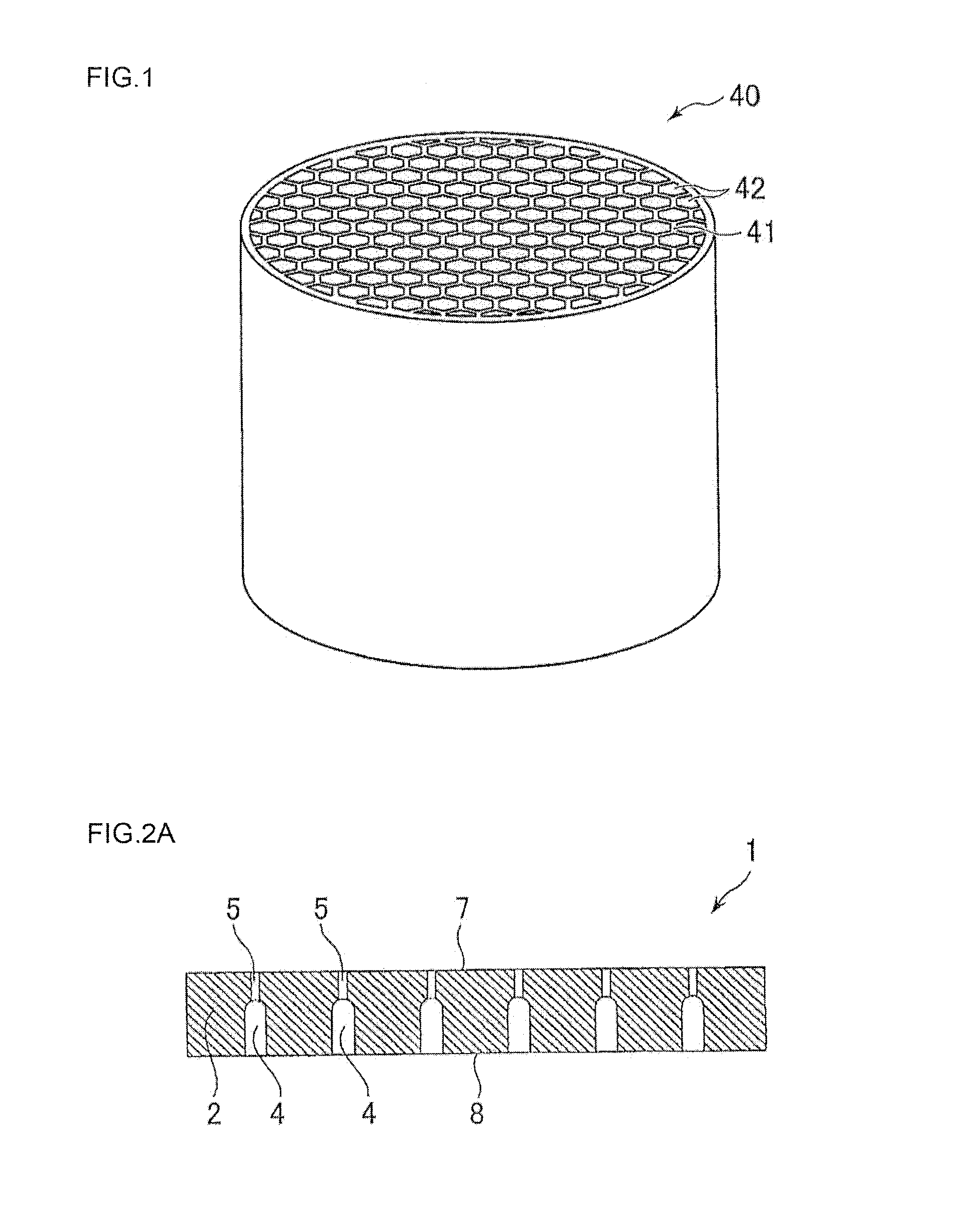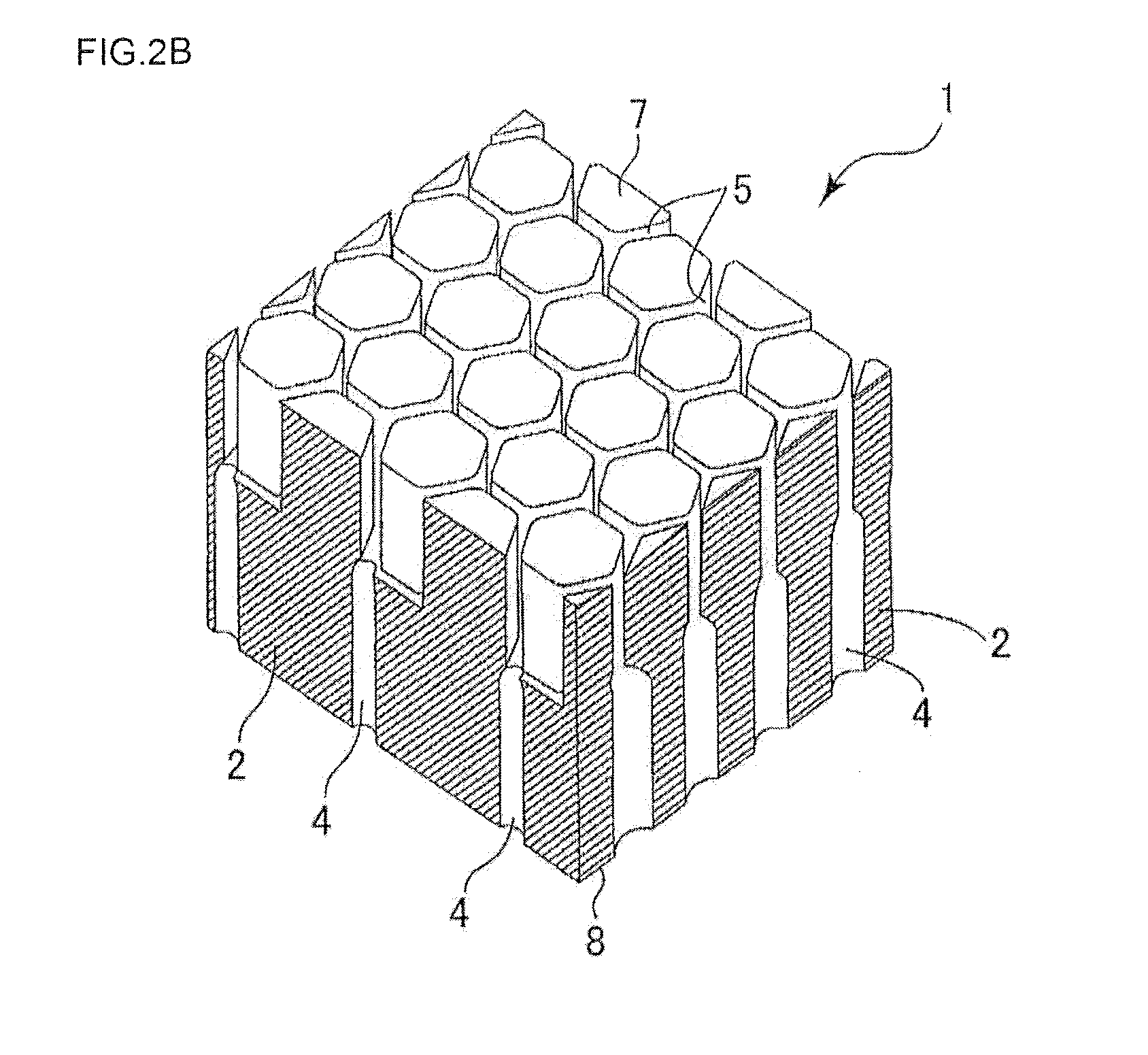[0026]According to a manufacturing method of an electrode for a honeycomb structure forming die of the present invention, one or more processing electrodes having a shape which is complementary to that of flow-through cells are arranged at positions corresponding to the plurality of flow-through cells in any surface of an electrode base body, and
electricity is discharged from the one or more processing electrodes toward the surface of the electrode base body, so that a plurality of electrode cells having a shape which is analogous to that of the flow-through cells are formed in the electrode base body. There is obtained the honeycomb electrode in which the plurality of electrode cells partitioned by electrode partition walls appear on at least one of the surfaces of the electrode. Therefore, as compared with a combtooth-like electrode including flat plate-like projections, the electrode partition walls can further be thinned or made finer while maintaining a desirable shape. In consequence, the honeycomb electrode manufactured by the manufacturing method of the electrode for the honeycomb structure forming die according to the present invention is suitable as an electrode for use in obtaining a die including narrower or finer slits. Moreover, according to the die including the narrower or finer slits, it is possible to form a honeycomb structure including thinner porous partition walls. For example, according to the manufacturing method of the electrode for the honeycomb structure forming die of the present invention, 0.01 mm is realized as a thickness of each electrode partition wall of the obtained honeycomb electrode. In the conventional combtooth-like electrode, the flat plate-like projections themselves are arranged away from one another, and cannot keep strength, and for maintaining the desirable shape, a thickness of each flat plate-like projection has a limit of 0.03 mm.
[0027]According to a preferable configuration of the manufacturing method of the electrode for the honeycomb structure forming die of the present invention, a plurality of through holes are made at positions corresponding to the plurality of flow-through cells of the electrode base body, before discharging the
electricity. Therefore, processed
sludge can quickly be discharged from processed portions, and it is possible to continuously perform stable
electric discharge machining. If the
sludge just generated by the processing remains, the electricity discharging becomes unstable, and a processing defect might be generated. However, according to the preferable configuration of the manufacturing method of the electrode for the honeycomb structure forming die of the present invention, such a problem does not easily occur. For example, when an electric
discharge machining oil is sucked or jetted through the through holes on a side opposite to a side on which the processing electrodes are arranged, the
sludge generated by the processing can be discharged through the processed portions through a flow of the electric
discharge machining oil. The through holes preferably have a size such that the sludge can suitably be discharged through the through holes and that the strength of the electrode base body or the honeycomb electrode is not influenced. When the electrode cells pass through the portion between the two surfaces of the electrode base body or the honeycomb electrode, the whole through holes become so-called precursor holes of the electrode cells. Moreover, even when the electrode cells do not pass through the portion between the two surfaces of the electrode base body or the honeycomb electrode, through hole portions corresponding to portions provided with the electrode cells become the precursor holes of the electrode cells. Therefore, when the size of each through hole that is to become the precursor hole of this electrode
cell is set to be close to that of each electrode
cell, a processing amount becomes small, less sludge is generated, and the stable electric
discharge machining can be performed.
[0028]Since the honeycomb electrode which is a manufacturing object of the present invention is used for processing the die, the plurality of electrode cells partitioned by the electrode partition walls may appear on at least one surface of this honeycomb electrode. In other words, the electrode cells do not have to pass through the portion between the two surfaces of the electrode base body or the honeycomb electrode. In this case, the plurality of electrode cells partitioned by the electrode partition walls may appear only on one surface of the honeycomb electrode. Moreover, any hole is not present or the above through holes are open in the surface of the honeycomb electrode on which any electrode
cell does not appear. The honeycomb electrode having such a configuration has a higher strength as compared with a honeycomb electrode through which the electrode cells pass. Furthermore, even when the through holes are made, the through holes may have a size to such an extent that the sludge can suitably be discharged as described above. When the through holes are made, the through holes do not have to pass with the same sectional shape, e.g., a round shape. For example, portions which become the above precursor holes of the electrode cells are made to be as large as the shape of the electrode cells, and only part of the remaining portions, e.g., only about ⅓ of the round sectional shape passes through the honeycomb electrode. In such a configuration, the strength becomes higher. The manufacturing method of the electrode for the honeycomb structure forming die according to the present invention is means for arranging one or more processing electrodes having the shape which is complementary to the flow-through cells, at positions corresponding to the plurality of flow-through cells in any surface of the electrode base body, and discharging the electricity from the one or more processing electrodes toward any surface of the electrode base body to carve the electrode base body. Therefore, when this
carving degree or depth is adjusted, it is possible to easily obtain the honeycomb electrode in which the plurality of electrode cells partitioned by the electrode partition walls appear only on one surface thereof and which is excellent in strength. This honeycomb electrode which is excellent in strength does not easily break or is not easily deformed during the electric discharge machining for obtaining the die.
[0029]In the manufacturing method of the electrode for the honeycomb structure forming die according to the present invention, one or more processing electrodes are arranged at the positions corresponding to the plurality of flow-through cells. In a preferable configuration of the method, the plurality of processing electrodes are integrated through a support portion. Therefore, the electricity is simultaneously discharged from the plurality of processing electrodes toward the surface of the electrode base body to advance the
carving of the electrode base body, so that the plurality of electrode cells having a shape which is analogous to that of the flow-through cells can be formed in the electrode base body. In consequence, according to the preferable configuration of the manufacturing method of the electrode for the honeycomb structure forming die of the present invention, it is possible to prepare the honeycomb electrode in a short time. On conditions of the same processing, processing time or the number of process steps may be 20% or can be saved by 80%, as compared with a case where the processing is performed by using a wire electric discharge
machine (WEDM).
 Login to View More
Login to View More 


